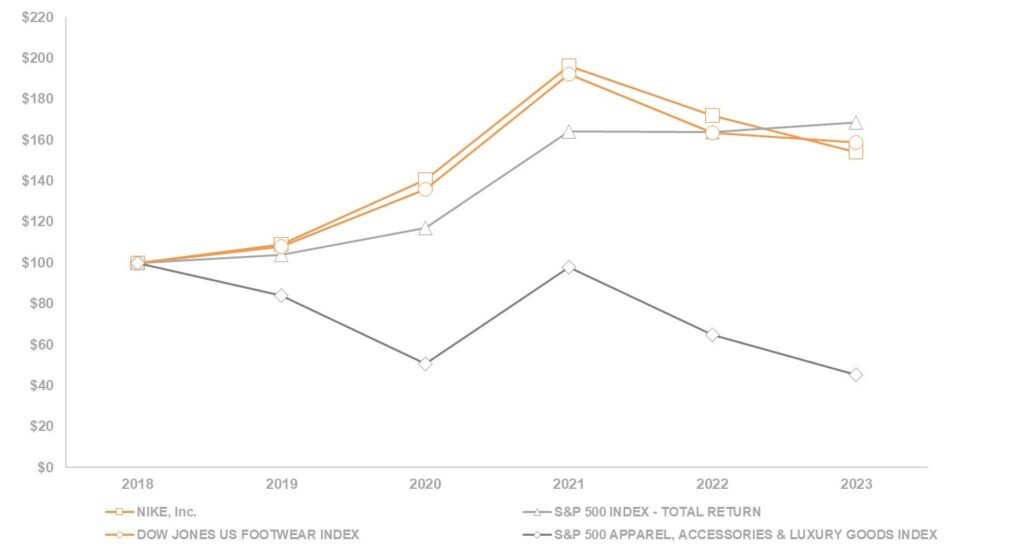
Asset Structure Analysis

Nike’s total assets were $37.5 billion as of May 31, 2023, in which total current assets were $25.2 billion, property, plant and equipment, net were approximately $5.1billion, and operating lease right-of-use assets, net were $2.9 billion.

Among total current assets, cash and cash equivalents were $7.4 billion, short-term investments were $3.2 billion.
It is clear that Nike hold a lot of cash, including cash and cash equivalents, and short-term investments.
Liquidity and Solvency

Total current liabilities were $9.26 billion as of May 31, 2023.
The current ratio was about 272% for fiscal 2023.
Total liabilities were about $23.5 billion as of May 31, 2023.
The debt ratio was about 62.7% for fiscal 2023.
As you can see that the amount of total current assets($25.2 billion) was more than that of total liabilities($23.5 billion).
Nike’s liquidity is very strong with moderate debt.
Profitability Analysis

Nike ‘s revenues were $51.2 billion, $46.7 billion and $44.5 billion in fiscal 2023, 2022 and 2021, respectively.

Net income was $5.07 billion, $6.05 billion and $5.73 billion for fiscal 2023, 2022 and 2021, respectively.
The net profit margin was 9.9%, 13% and 12.9% in fiscal 2023, 2022 and 2021, respectively.
Total shareholders’ equity was $14 billion and $15.3 billion in fiscal 2023 and 2022, respectively.
The return on equity was 36.2% and 39.5% in fiscal 2023 and 2022, respectively.
Cash Flow Analysis

Cash provided by operations was $5.84 billion, $5.19 billion and $6.66 billion in fiscal 2023, 2022 and 2021, respectively.
Stock-based compensation was $755 million, $638 million and $611 million in fiscal 2023, 2022 and 2021, respectively.
The amount of stock-based compensation has made up 1/10 of cash provided by operations.

Additions to property, plant and equipment were $969 million, $758 million and $695 million in fiscal 2023, 2022 and 2021, respectively.
There is two factors, stock-based compensation and additions to property, plant and equipment, which reduce the valuation of company.

Repurchase of common stock was $5.48 billion, $4 billion and $608 million in fiscal 2023, 2022 and 2021, respectively.
Dividends were $2 billion, $1.84 billion and $1.64 billion in fiscal 2023, 2022 and 2021, respectively.
The amount of repurchase of common stock and dividends is the capital returned to shareholders.
In past three years, the capital returned to shareholders averaged about $5.189 billion per year.
Given that stock-based compensation would be setoff by repurchase of common stock, we estimate that the capital returned to shareholder is about $4.5 billion per year.
Nike ‘s operating performance for the quarterly period ended February 29, 2024
Revenues were $38.76 billion and $38.4 billion in nine months ended to February 29, 2024 and nine months ended to February 28, 2023.
Net income was $4.2 billion and $4 billion in nine months ended to February 29, 2024 and nine months ended to February 28, 2023.
Cash provided by operations was $4.8 billion and $3.6 billion in nine months ended to February 29, 2024 and nine months ended to February 28, 2023.
Conclusion
Based on conservative principles, we reckon that Nike’s reasonable valuation is about $80 billion, while the company’s market capitalization is $109.73 billion, which is equivalent to $72.70 per share.
Disclaimer: The content is for reference only and does not constitute investment advice.
Introduction
NIKE designs, develops, markets and sells athletic footwear, apparel, equipment, accessories and services worldwide. We are the largest seller of athletic footwear and apparel in the world. We sell our products through NIKE Direct operations, which is comprised of both NIKE-owned retail stores and sales through our digital platforms (also referred to as “NIKE Brand Digital”), to wholesale accounts and to a mix of independent distributors, licensees and sales representatives in nearly all countries around the world. Our goal is to deliver value to our shareholders by building a profitable global portfolio of branded footwear, apparel, equipment and accessories businesses. Our strategy is to achieve long-term revenue growth by creating innovative, “must-have” products, building deep personal consumer connections with our brands and delivering compelling consumer experiences through digital platforms and at retail.